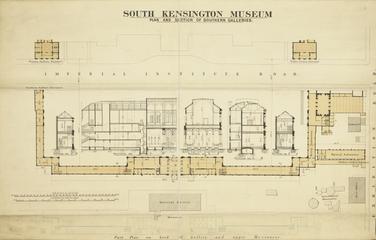
South Kensington Museum
The South Kensington Museum had its origins in the Great Exhibition of 1851, which the museum's first director, Henry Cole, was involved in planning. It was initially known as the Museum of Manufactures and first opened in May 1852 at Marlborough House, but by September had been transferred to Somerset House. At this stage the collections covered both applied art and science. Several of the exhibits from the Great Exhibition were purchased to form the nucleus of the collection. Henry Cole declared that the Museum should be a “schoolroom for everyone”, with the mission of improving the standards of British industry by educating designers, manufacturers and consumers in art and science. Acquiring and displaying the best examples of art and design contributed to this, as did the construction of the museum’s buildings themselves, which were also intended to demonstrate exemplary design and decoration.
By February 1854 discussions were underway to transfer the museum a site at South Kensington and it was renamed South Kensington Museum. The new institution’s first new building was an iron framed building clad in corrugated iron, nicknamed the Brompton Boilers due to their industrial look. The official opening by Queen Victoria was on 20 June 1857. At the time the site also hosted the Patent Office Museum, a collection of contemporary and historical machinery, including an early Boulton & Watt beam engine and Symington’s marine engine. In 1862 the locomotives ‘Puffing Billy’ of 1814 and Stephenson’s ‘Rocket’ of 1829 were put on display and these were followed in 1864 by the first part of the museum’s collection of ship models.
From the 1860s to the 1880s the South Kensington Museum’s scientific collections were moved from the main museum site to various improvised galleries to the west of Exhibition Road, using buildings originally constructed for the 1862 International Exhibition. These collections continued to grow, but by a sequence of sudden additions and changes rather than by any consistent planning. A major step forward came in 1876, when an exhibition, the ‘Special Loan Collection of Scientific Instruments’ was held. It was a great occasion. Instruments and equipment from many countries were displayed and public lectures given on the progress of science world-wide. In 1883 another change of emphasis occurred when the contents of the Patent Office Museum were formally transferred to the South Kensington Museum. At about the same time a Science Library was established which ever since has served the needs of Museum staff, college students and the general public.
In 1893 the Science Museum effectively came into existence when a separate director was appointed, though construction did not commence on the Science Museum building until 1914 and it was still administered as part of the South Kensington Museum. The Art collection was to get a new building before this when in 1899 Queen Victoria laid the foundation stone of a new range of buildings. She also directed that in future the Museum should be renamed 'The Victoria and Albert Museum' and this title, somewhat confusingly to us now, also applied to the Science Collections.
In 1909, when the new buildings were opened, the title was confined to the Art Collections. The Science and Engineering Collections were finally separated administratively and the name 'Science Museum', in informal use since 1885, was officially adopted. It was on June 26th that year that the institutional reorganisation into two independent institutions was ratified and the title "Science Museum" was officially bestowed. This nomenclature was largely down to the brilliance of Norman Lockyer, the founder-editor of the journal Nature and to senior civil servant Robert Morant.
Lockyer's association with the collections since the 1876 Loan exhibition and persistent lobbying on the museum's behalf qualifies him to be described as the founder of the museum while Morant engineered the separation from the Victoria and Albert Museum. Throughout the late 1800s and first decade of the 1900s Lockyer argued for the importance of a museum distinctively dedicated to Science. As early as 1876 he had ploughed ahead with assembling thousands of scientific instruments, objects and articles in South Kensington and these were subsequently incorporated in The South Kensington Museum, which had originally been founded to promote industry but whose art collections were in their turn increasingly oriented towards art rather than industry. The pressure from outside government by men such as Lockyer and from within by Morant seemed to work; by mid-1908 questions were being asked in the House of Commons for the establishment of a "science museum properly housed in immediate proximity to the Imperial College of Science and Technology". By June 1909 Morant saw the chance for a separate museum for science when ministers voted to rename The Kensington Museum; once they had approved the new name 'Victoria and Albert Museum' he reminded them the late Queen Victoria had intended the title (first mooted in 1899) only to apply to an art museum. There had to be a Science Museum for the scientific collections accumulated at The Kensington Museum, as the 'V&A' title could not possibly apply to anything but the art collections. The ministers acquiesced.